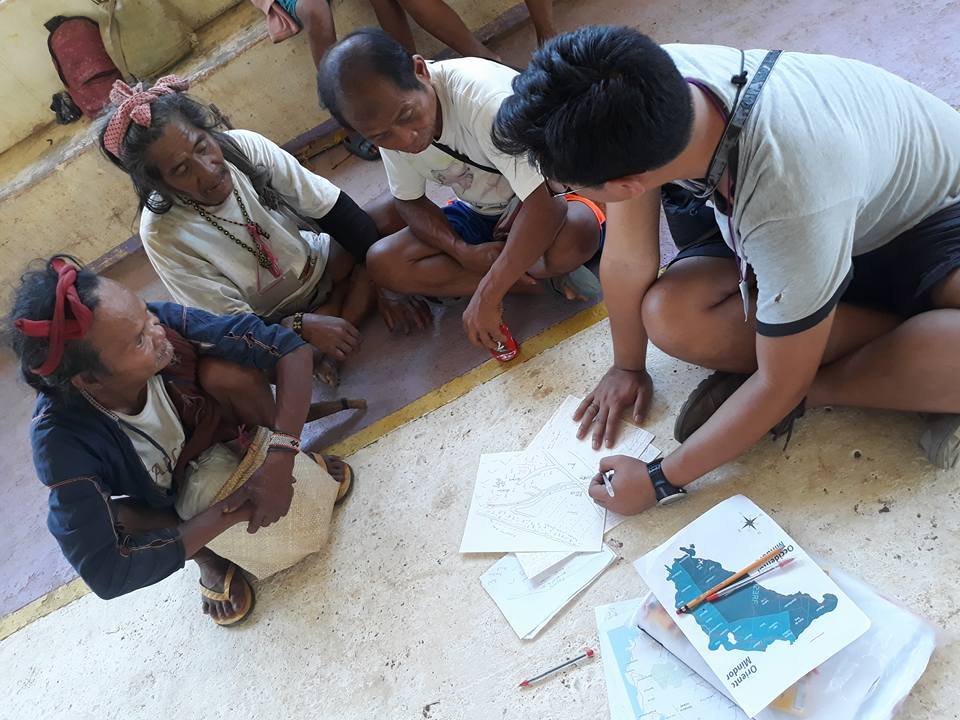Conversation with Cian Dayrit
2023 Sovereign Asian Art Prize Finalist
By Nadya Wang
Cian Dayrit. Image courtesy of the artist and The Sovereign Art Foundation.
Cian Dayrit is an artist practising in the Philippines who focuses on unlearning and spreading the word on structural injustices in society. By examining and subverting maps, monuments, museums and other sources of grand narratives, he questions the powers that be, and makes space for the stories of marginalised communities. In his reimaginations of received realities, he prompts us to not only reflect on our own contexts, but to take action to change them for the better. In this conversation, Cian talks about the impact that his formal education had on his practice, his enduring interest in maps and the messages he sets out to convey through his works.
You received your education at the University of the Philippines. What aspects about your education did you enjoy, and what less so? And how has your formal training contributed to your artistic practice?
Art education in the Philippines – and much of the global south, presumably – is very much oriented towards the dominant market economy of contemporary art. It is a good barometer of what society expects out of the artists it “produces” or better yet how society defines the parameters of artistic practice. I take this as a starting point to figure out what we must unlearn, or where we can turn to as we expand notions of artistic practice and activate cultural work. My professors recognised this paradox and welcomed this attitude of challenging dominant narratives. I am grateful to have gone through a space that allows for progressive transformations. I wish to contribute to such spaces.
Mapping workshop in 2017/2019. Image courtesy of the artist.
When did the fascination with maps begin? And could you elaborate on how they have helped to order the world through colonialism or otherwise, and what you wish to challenge/change in making your cartographic artworks?
I am drawn to objects of power. Studying these objects and learning about how civilisation birthed them was the basis of my practice as I was starting out. The map is one such object/subject of fascination as I learn about how space and place have shaped our histories.
You incorporate embroidery and textile into your cartographic artworks. How do these help to complete the artworks materially and/or conceptually?
Much of my tapestries respond to European tapestries representing territory. These majestic objects glorified feudal relations and violent power dynamics. My work subverts these traditions. Beyond this, I am interested in reclaiming and redistributing the innate power of the cartographic interface as I/we expand its authorship to express the struggles and aspirations of the masses.
“The pictorial image can be read as literature, just as the written language can be viewed as an image. Text and the intricacies of language can be utilised to tease out nuanced workings of communication. Between the subtle and the explicit, the metaphorical and the literal, my work attempts to utilise all tools of communication. ”
Text features significantly in many of your works. Could you talk about the incorporation of text in your works, such as ‘Tree of Death and Decay’ (2018) and ‘Protest Party Banner’ (2019)? When do you find it compelling to explicitly spell out what you would like to express in your works?
The pictorial image can be read as literature, just as the written language can be viewed as an image. Text and the intricacies of language can be utilised to tease out nuanced workings of communication. Between the subtle and the explicit, the metaphorical and the literal, my work attempts to utilise all tools of communication.
Dominant modalities of literacy were used by colonisers to streamline the spread of religion and influence colonial subjects. In the same manner, literature has also been used to spread anti-colonial ideals back into the global south. My work hopes to be aligned to the use of language in the latter.
Cian Dayrit, 'Adversus Contradictores I', 2019, textile, 183 x 122 cm. Image courtesy of Pintô.
Could you talk about the ‘Adversus Contradictores’ (2019) series? It is a complex work with faith-based symbols, the anting-anting, an imagined iconography and Latin words. How did all these come together, so that we may be able to understand a little of your working process when conceptualising and creating an artwork?
The series ‘Adversarius Contradictores’ is based on the visual language of the anting-anting talismans. Just like maps, I attempt to dissect the pictorial vocabularies of these quasi-religious objects and supplement it with my own image and text. In this particular set, I speak about the entanglements of patronage in varying levels. On the broader scale, I tackle issues of sovereignty and neo-colonialism in Philippine society. Upon closer look, I also talk about a prominent art patron who used his influence to stop the arrest of a plunderer.
Tinang 83 movement in June 2022. Image courtesy of SAKA.
Your work often focuses on the plights of marginalised communities. In June 2022, you were arrested along with dozens of other artists while fighting for farmers’ rights. Could you tell us more about what happened, and in what ways you have continued to push for the cause since then, whether in your artistic practice or elsewhere?
Please read, sign and share this link. These are recurring stories in the Philippines and we need to keep telling these stories until they become cautionary tales rather than reportage.
Cian Dayrit, 'Darkly Seeing the Unseen', 2022, installation shot from the Ateneo Art Awards 2022: Fernando Zóbel Prizes for Visual Art Return Exhibition. Image courtesy of Ateneo Art Gallery.
While your work is made from the perspective and experience of living in the Philippines as a former Spanish colony, it transcends the localised experience to resonate with many who have similar histories. Could you tell us about recurring symbols/motifs that you employ to make a statement about these circumstances?
Spanish, American, Japanese, American and neo-colonial – these chapters are not artefacts of the past but are living vestiges of systemic historical oppression. And it is similar everywhere else. The global south is over-exploited by imperialist states and multinational corporations, dictating the way we live, the landscapes we inhabit, the relationships we have and the worldviews we subscribe to.
My visual language evolves from my grasp of my own political identity and positionalities in relation to social conditions. Much of it is based on imagery of faith practice, nature and how these images are used to wield power. Emblems, seals, flags, maps, monuments and more are used to build mythologies, belief systems, ideologies, paradigms, which in turn shape nature and notions of faith.
Cian Dayrit, 'Blueprint of Dam as Sadistic Monument', 2022, objects, embroidery and digital print on fabric. Image courtesy of Art Jameel.
Could you elaborate on ‘Blueprint of Dam as Sadistic Monument’ (2022)? Tell us about the five life-giving rivers that are featured, and what you hoped for visitors to the 23rd Biennale of Sydney (2022) to take away from the work?
‘Blueprint of Dam as Sadistic Monument’ (2022) or BDSM, presents the large dam as an imposing icon of destruction. As a structure, it is made to disrupt natural flows and convert nature into profit. It also disturbs the ecological balance as well as causes economic instability as these networks of infrastructure require foreign loans and in effect cause debt. The erection of these violent monuments on indigenous land come in the form of militaristic ventures as they displace communities, ignore indigenous customary laws, and override democratic rights. The six river ecologies presented in the tapestry are currently facing new large dam projects from Duterte’s Build Build Build programme to Marcos’ Build Better More programme. I mention these names with disgust. The piece talks about large dams for what they are – contradictions. They contradict nature, cultures, economies, justice.
These aggressive development projects are not isolated to the Philippines. The broad environmental movement started as a protest to a large dam. At best, I want to contribute to the discourse of development aggression and the intersections of resistance.
Your work has been shown across the world at various biennials. In addition to the Sydney Biennale, you have exhibited at the Gwangju Biennale, Berlin Biennale for Contemporary Art, Dhaka Art Summit, New Museum Triennial, Göteborg Biennial, and at the Kathmandu Triennale. How does the experience of showing your work at various places further shape your work as an artist?
I recognise that my audience is vast and acknowledge this as a responsibility to give justice to the stories I share and the calls I echo.
I welcome opportunities where my work can converse with other work. In these platforms, we share not only space but stories and evolving contexts.
I try to find connections with audience from different historical and political contexts while building stronger networks of international solidarity against oppressive systems.
I respond and collaborate with curators and other cultural workers just as we respond and collaborate with ever expanding communities through our audiences. We maintain our artistic, intellectual and ideological bearings as we forge alliances and strengthen relationships.
Cian Dayrit, 'The Austere Enclave', 2023, installation view. Image courtesy of MONO8 and Cian Dayrit Studio.
How do you strike a balance among staying true to your artistic vision and practice, maintaining financial stability and living life?
This balance should be viewed as basic logic as we navigate through contradictions and everyday struggles. I consult with trusted comrades and practise self-criticism while acknowledging that my status affords me the time and energy to dedicate my practice to a just and democratic world.
We must not overlook the importance of making kin and building community as we strive to address society’s ills, for these ills are structural and systemic.
This interview has been edited.
Cian Dayrit is one of 30 artists shortlisted for the 19th Sovereign Asian Art Prize. He is in the company of six other Southeast Asian artists: Bjorn Calleja and Luis Antonio Santos from the Philippines, Faris Nakamura from Singapore, Justin Lim from Malaysia, and Alisa Chunchue from Thailand and Nguyễn Thế Sơn from Vietnam. All 30 works can be seen online, and will also be shown at H Queen’s in Hong Kong from 10 to 18 May 2023. Please click here for more information about the Sovereign Art Foundation and the Sovereign Asian Art Prize. The 2023 Sovereign Asian Art Prize Gala Dinner and Charity Auction will be held on 19 May 2023 in Hong Kong.
Art & Market is proud to be an official media partner of the 2023 Sovereign Asian Art Prize.





















